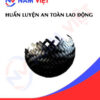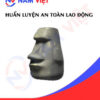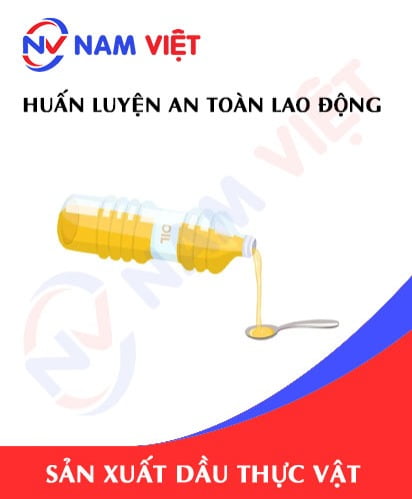Occupational Safety Training for Consumer Goods Manufacturing
99,000 ₫
Note: The above price is calculated per person, the price may vary depending on the number of participants in the training course and the fluctuations of the market. For more accurate price support, please refer to the quotation table or contact our consulting staff directly.
Occupational safety is an important issue in consumer goods manufacturing factories and needs to be addressed promptly to ensure the health and safety of workers and enhance the reputation of businesses. The Occupational Safety Training course is one of the effective solutions to raise awareness about preventing workplace accidents for workers participating in consumer goods production.
Table of Contents
Toggle1. Overview of Consumer Goods
a. What are consumer goods?
Consumer goods are products purchased and used daily to meet basic human needs. These are common items frequently appearing in everyday life, including products such as food, beverages, clothing, household items, personal care products, electronics, home appliances, and many other types of goods.
Consumer goods are typically produced and consumed continuously, not only in the domestic market but also in international markets. Businesses producing and trading consumer goods usually need to meet consumer demands by providing quality, diverse products suitable for their cost.
The consumer goods sector plays an important role in the economy and is often considered an indicator of the health of the consumer market.

b. Machinery for consumer goods production
Many types of machinery are involved in the production process of consumer goods. Below are some common types of machinery in the consumer goods manufacturing industry:
- Packing machines: These machines are used to pack products into packaging or boxes for protection and preservation. Packing machines may include bag packing machines, carton packing machines, shrink wrap machines, bottle packing machines, and many other types to meet specific product requirements.
- Food processing machinery: In the food production sector, various machines are used to handle and process food ingredients. This includes cutters, mixers, presses, roasting machines, capping machines, beverage preparation machines, food packaging machines, and other machinery to produce packaged food products.
- Clothing and footwear production machinery: In the fashion industry, there are specialized machines for producing clothing, shoes, and accessories. These machines include industrial sewing machines, fabric cutting machines, weaving machines, printing machines, embroidery machines, heat press machines, and others for fashion product manufacturing.
- Electronics manufacturing machinery: In the electronics industry, machines are used to assemble and produce electronic products such as mobile phones, computers, televisions, smart home devices, and many other devices. These machines include automated assembly machines, soldering machines, quality inspection machines, PCB printing machines, and many others for electronics production.

c. Consumer goods manufacturers in Vietnam
Vietnam has many consumer goods manufacturers operating across various sectors. Below are some examples of consumer goods manufacturers in Vietnam:
- Masan Group: One of the leading corporations in Vietnam, Masan Group operates in multiple sectors such as food (Masan Consumer), beverages (Masan Beverages), household products (Masan Homecare), and pharmaceuticals (Masan Nutri-Science).
- VinGroup: VinGroup is one of the largest multi-industry conglomerates in Vietnam. The company produces and trades products such as mobile phones (VinSmart), household electronics (VinPro), food (VinMart), and fashion (VinFashion).
- TH True Milk: A leading dairy company in Vietnam, TH True Milk operates in dairy farming, production, and distribution of milk and dairy products.
- Trung Nguyên Group: Trung Nguyên is a leading coffee manufacturer and distributor in Vietnam, specializing in roasted coffee, instant coffee, and related products.
- TH Group: TH Group specializes in milk and dairy products production in Vietnam. The company also invests in dairy farming projects and modern milk processing plants.
- Sabeco (Saigon Beer – Alcohol – Beverage Corporation): Sabeco is one of the leading beer producers in Vietnam. The company produces and distributes well-known beer brands such as Bia Saigon, Bia 333, and Bia Tiger.

d. Specific jobs in a consumer goods manufacturing plant
Group 1
- Executive directors, deputy directors, and department heads in a consumer goods manufacturing plant.
Group 2
- Safety officers: manage safety in the factory, design safety procedures, supervise and ensure staff compliance with safe work processes.
Group 3
- Procurement and supply management: Includes sourcing suppliers, negotiating contracts, quality inspection, and managing the supply of materials and production inputs.
- Quality management: Ensures production processes comply with quality standards, inspects and controls product quality, and addresses quality-related issues.
- Production and processing: Core work in the factory, where workers and technicians handle production steps from raw material processing to assembly, packaging, and labeling.
- Maintenance and repair: Ensures continuous operation of equipment and machinery. They perform routine maintenance, repairs when necessary, and monitor equipment performance.
- Packing and logistics: Includes packaging finished products, labeling, sealing, and preparing products for delivery to sales points or storage warehouses.
Group 4
- Office, support, sales, and marketing work.
- Production management: Oversees overall production, plans production schedules, manages timelines, and coordinates workers and resources.
- Research and product development: Analyzes the market, develops new products, upgrades existing products, and ensures competitiveness in the industry.
2. Overview of occupational safety training for consumer goods production
In this article, we focus on Group 3, because Group 3 is directly involved in production and is exposed to the highest occupational safety risks. For reference on other groups, see here.
a. What is Group 3 occupational safety training?
- Group 3 occupational safety training consists of sessions that provide awareness on how to prevent workplace accidents for workers.
- The training helps workers identify and avoid hazards, reducing risks of accidents during work.
REGISTER FOR OCCUPATIONAL SAFETY TRAINING
b. Training duration
Initial occupational safety training
- Total training hours are at least 24 hours, including assessment time.
- 8 hours theory on occupational safety policies and laws
- 8 hours theory on basic occupational safety knowledge
- 4 hours theory on specialized training content
- 2 hours practical training on specialized content
- 2 hours theoretical assessment at the end of the course
The training center schedules sessions according to workers’ availability, usually 6 sessions over 3 days if continuous training is feasible.
Periodic occupational safety training
- Before the occupational safety card expires, workers needing renewal must complete a periodic occupational safety training course, with duration at least 50% of the initial training hours.
Explanation: Total periodic occupational safety training duration is at least 12 hours, including assessment. After completion and passing the assessment, workers are issued renewed occupational safety cards.
c. Training content
| No. | TRAINING CONTENT | TRAINING DURATION (HOURS) | |||
| Total | Including | ||||
| Theory | Practice | Assessment | |||
| I | Occupational safety policies and legal system | 8 | 8 | 0 | 0 |
| 1 | Overview of legal documents on occupational safety and hygiene. | 6 | 6 | ||
| 2 | Standards and technical regulations on occupational safety and hygiene. | 1 | 1 | ||
| 3 | Specific regulations of state management agencies on occupational safety and hygiene when building, expanding, or renovating production facilities, using, storing, and inspecting machinery, equipment, materials, and substances with strict safety and hygiene requirements. | 1 | 1 | ||
| II | Basic occupational safety knowledge | 8 | 8 | 0 | 0 |
| 1 | Basic knowledge of hazards and harmful factors at the workplace. | 4 | 4 | ||
| 2 | Methods to improve working conditions. | 1 | 1 | ||
| 3 | Safety culture in production and business. | 1 | 1 | ||
| 4 | Rights and obligations of employers and employees; occupational safety policies and regulations; functions and duties of safety officers. | 1 | 1 | ||
| 5 | Safety and hygiene regulations, signs, guidance boards, use of safety equipment, personal protective equipment; first aid skills, occupational disease prevention. | 1 | 1 | ||
| III | Specialized training content | 6 | 4 | 2 | 0 |
| Comprehensive knowledge of machinery, equipment, substances generating hazards; risk analysis, occupational safety management, safe working procedures for machinery, equipment, and substances with strict safety requirements. | 6 | 4 | 2 | ||
| IV | Final assessment of occupational safety training | 2 | 2 | 0 | 0 |
| Total | 24 | 22 | 2 | ||
See more training content for all 6 groups
d. Occupational safety card
After completing the occupational safety training and passing the assessment, workers are issued a Group 3 occupational safety card (commonly referred to as Group 3 occupational safety certificate).
The Group 3 safety card includes information such as name, date of birth, job, and specific work environment. It also shows training duration, red stamp, and signature confirming course completion.
According to issuance regulations under Clause 2, Article 24 of Decree 44/2016/ND-CP, there are 2 cases:
- If the employer and employee have an employment contract, the employer must sign, stamp, and validate the safety card after the worker completes training and passes the assessment.
- If the worker is freelance or seasonal, without an employment contract, the training unit must sign, stamp, and validate the safety card after training and passing the assessment.

3. Identifying hazards affecting workers in consumer goods production
Consumer goods production can involve numerous hazards that affect the health and safety of workers. Below are some common hazards in the consumer goods manufacturing process:
- Chemical hazards: Consumer goods factories often use chemicals for production, cleaning, and product preservation. Exposure to toxic chemical compounds can harm health, cause skin inflammation, respiratory problems, muscular toxicity, and may even lead to cancer.
- Physical hazards: The consumer goods production process may involve the use of machinery, equipment, and tools that can cause injuries, accidents, and burns. Additionally, noise, vibration, and intense light can also affect workers’ health.
- Electrical safety hazards: During production, workers may come into contact with electronic devices, machinery, and electrical wires. Non-compliance with electrical safety regulations can lead to risks of electric shock, fire, or other electrical incidents.
- Hygiene and biological hazards: Some consumer goods factories may face risks of bacterial, viral, or other biological agent contamination. This is especially critical in the food and beverage industry, where adherence to hygiene standards and procedures is extremely important.
- Machinery operation hazards: Machinery and equipment in consumer goods factories can be dangerous if not operated properly. Risks include entrapment, collisions, imbalance, and machinery-related accidents.

4. Common workplace accidents in consumer goods production
During consumer goods production, there are several types of workplace accidents that commonly occur. Below are some typical accidents workers may encounter in the consumer goods industry:
- Machinery accidents: Workers may experience accidents when working with unsafe machinery or when safety regulations are not followed. This includes entrapment, collisions, crushing, cuts, or explosions caused by machinery malfunctions.
- Accidents with materials and tools: Workers may have accidents when using materials, tools, or equipment incorrectly. For example, accidents may occur when using knives, cutting tools, welding equipment, or handling hazardous chemicals.
- Accidents from falling heavy objects: During production, transporting and moving heavy objects can cause accidents. If safety measures are not observed, falling objects can injure workers.
- Accidents from toxic substances and biological agents: Consumer goods production may involve hazardous chemicals or exposure to biological agents like bacteria and viruses. Failure to follow safety and protection guidelines can lead to poisoning or infections.
- Electrical accidents: Using electrical equipment, machinery, and systems in factories can cause electric shock or fire if not handled safely.
- Accidents from other hazards: Other hazards such as noise, intense light, vibration, or confined workspaces can also cause accidents and affect workers’ health.
5. Safety measures in consumer goods production
When participating in consumer goods production, several key safety measures must be followed to ensure workers’ safety. Common safety measures include:
- Compliance with occupational safety regulations: Workers should follow safety procedures set by the company and regulatory authorities. This includes reading and understanding safety instructions, work procedures, and protective equipment usage rules.
- Training and education: Providing safety training and education to workers is crucial. It helps them recognize hazards, understand preventive measures, properly use protective equipment, and follow safety protocols while working.
- Use of protective equipment: Ensure workers wear protective gear such as helmets, safety glasses, masks, gloves, protective clothing, and safety shoes to protect against injuries, chemical exposure, and other workplace hazards.
- Chemical hazard control: Manage and control chemicals during production. This includes using safe chemicals, labeling hazardous substances correctly, providing safety instructions and personal protective guidance, and ensuring proper storage and handling.
- Equipment maintenance and inspection: Perform regular maintenance and inspection of machinery and equipment to ensure safe and efficient operation. Regular checks help identify potential hazards and ensure equipment is safe to use.
- Risk management and prevention: Assess potential hazards and implement preventive measures to minimize risks. This includes risk analysis, determining safety measures, providing guidance and training, and effectively managing risks.
- Create a safe working environment: Maintain cleanliness and hygiene, ensure sufficient lighting and ventilation, control noise and vibration, and monitor pressure and temperature levels.
- Participation in communication and feedback: Establish a safety culture where everyone participates in safety communication, reports hazards and incidents, suggests improvements, and provides feedback on safety issues.
- Periodically conduct workplace environment monitoring in factories, collect and analyze harmful factors affecting workers, and adjust to reduce hazards to prevent occupational diseases.
6. Benefits of occupational safety training in consumer goods production
An Toan Nam Viet provides businesses with the following benefits after completing occupational safety training courses in accordance with Decree 44/2016/ND – CP regarding occupational safety and hygiene:
- Workers can identify potential hazards and take preventive measures to avoid accidents.
- Businesses can establish risk prevention measures in production, operation, and maintenance processes.
- Reduce costs associated with workplace safety incidents.
- Continuous production enhances labor productivity and product quality.
- Compliance with occupational safety laws, avoiding legal risks.
- Enhance reputation and professionalism, thereby elevating the business brand.
Nam Viet training courses provide solutions to prevent external hazards from affecting individuals, helping them avoid injuries or even fatalities.
REGISTER FOR OCCUPATIONAL SAFETY TRAINING
7. Customer feedback after completing occupational safety training in consumer goods production
An Toàn Nam Việt has years of experience supporting businesses across Vietnam, particularly in the southern provinces. Our occupational safety training is highly professional, and the motivation for our growth comes from positive feedback and constructive suggestions from our clients. Below are some testimonials from our partners.
See more customer interviews after using the service from An Toàn Nam Việt
8. An Toàn Nam Việt’s Occupational Safety Training capabilities
An Toàn Nam Việt is a reputable and high-quality occupational safety training center in Vietnam. Training sessions are continuously held at factories, production sites, and construction sites nationwide (63 provinces in Vietnam).
REGISTER FOR OCCUPATIONAL SAFETY TRAINING
Occupational safety training license
- An Toàn Nam Việt has been inspected and certified by the Department of Labor Safety under the Ministry of Labor, Invalids, and Social Affairs, granting a certificate of eligibility for occupational safety and hygiene training. This reinforces our strong training capabilities.

Training materials and lectures
- Before being used in occupational safety training courses, training materials are reviewed to ensure knowledge accuracy and practical effectiveness.
- Teaching methods are standardized according to An Toàn Nam Việt standards, developed by experts in occupational safety and hygiene training to maximize learners’ knowledge absorption.
Facilities
- Controlling classroom factors affecting training improves teaching efficiency and learners’ knowledge retention.
- Our training facilities offer spacious classrooms that meet standards for area, lighting, and training equipment.
9. National reputable occupational safety training center
At An Toàn Nam Việt, we prioritize professional dedication to occupational safety training. We aim to equip workers with self-protection knowledge, contributing to a safer workforce and national development.
To ensure effective training, we meticulously prepare all aspects, from teaching tools, equipment, materials, to audio and lighting.
Our instructors are experts with years of experience, including research on identifying hazards across industries and prevention methods.
Lectures are practical, engaging, and easy to understand, allowing learners to absorb knowledge effectively. All content complies with Decree 44/2016/NĐ-CP.
Through this, workers learn hazard prevention measures and self-protection strategies, applying them appropriately in real work.
Our training center is proud to provide professional and reliable occupational safety training with the following advantages:
- Competitive training costs while maintaining quality.
- Flexible training schedules to fit company operations.
- Quick and legally compliant certification procedures.
- Instructors with extensive experience.
- Classroom conditions optimized for learning efficiency and knowledge retention.
- Lectures tailored to occupational safety in enterprises.
- An Toàn Nam Việt works diligently and professionally to support clients accurately and promptly.

10. Additional resources for occupational safety training in consumer goods production
- Occupational safety materials for consumer goods production
- Occupational safety training materials set
- Occupational safety training test set
- Occupational safety training curriculum for consumer goods production
- Occupational safety multiple-choice test for consumer goods production
1 review for Occupational Safety Training for Consumer Goods Manufacturing
No comments yet















namchinh.haiphong341
Bài giảng rất sinh động!